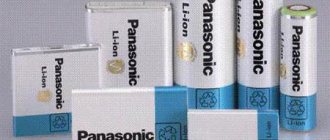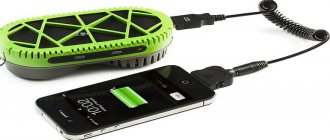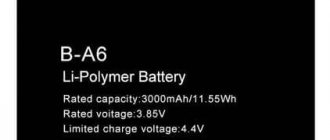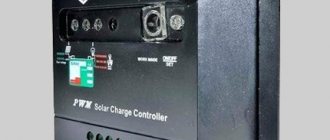09.05.2021
Do you need to know how to charge your phone correctly? At first glance, there is nothing to know. I inserted the cord into the phone, plugged it into the socket and you're done! But over time, the user notices that the phone has to be charged more often. This problem appears especially quickly on phones running Android. The battery on the iPhone lasts longer, but not every user can replace it themselves. Plus the battery itself will cost several times more.
The problem that the phone discharges faster over time is due to the fact that each battery model has a certain number of charge/discharge cycles. The cycles are affected by how many times energy was supplied through charging to the phone and how much you keep the charge of your smartphone at an average value.
That is, if you charge your phone not haphazardly, but correctly, you can increase the battery life. However, it is impossible to increase the battery life of your phone beyond that stated by the manufacturer.
For both iOS and Android devices, it is important to understand how to properly charge your phone so that the battery lasts longer. Let's figure out how to charge your phone correctly if:
- you bought a new phone;
- replaced the battery on the phone;
- The phone has been in use for some time now.
We’ll also tell you more about the phone’s charging/discharging cycles and how you can check them. Let's reveal the truth about Chinese charger manufacturers. Well, according to tradition, at the end of the article you will find advice from experts of the 100 Friends brand .
How to properly charge your phone if it's new?
When a person buys a new gadget for himself in the form of a smartphone, then almost the main thing he needs to know is how to charge the phone correctly the first time. After all, if you buy it and do not understand what capacity and type of element is installed, then there is a chance that the user will charge the new device incorrectly, which will result in severe wear and tear.
There are 2 types of batteries supplied from the factory:
- Lithium-ion;
- Lithium polymer.
They have no differences in everyday use, therefore, there is no need to worry about changing the principle of operation or anything else. If a person switches from a Li-Pol battery to Li-Ion, then nothing will change. And you don’t need to think about how to properly charge your phone with each of these types of batteries.
But sometimes people think that they need to charge gadgets until the “100%” mark appears next to the battery and discharge until the phone turns off completely
In some cases this is required, and someday it can even harm the battery in a smartphone. Therefore, you need to figure out how to properly charge a new smartphone.
Standard scenario
A person buys a smartphone, and then can simply charge it fully and use it as usual. No need to do any calibrations or anything else. That is, before sale, everything was done from the factory with the component installed in the smartphone. In view of this, the buyer receives a gadget completely ready for normal use.
The reason for the lack of calibration is that this has already been done at the factory. They not only assemble the devices, but also test the components to catch any problems early and fix them to avoid future problems. The factory uses recharge cycles for the battery, so you don’t have to think about how to properly charge your phone.
The calibration process itself goes like this:
- A man inserts an element into a smartphone;
- Charges the battery to maximum;
- Discharges it to 0%;
- Repeats several times for calibration to occur.
The important thing is that new smartphone models are delivered from the factory already calibrated. In view of this, deep discharge will not be allowed, which adversely affects the battery capacity and its operation.
Consequently, a person, having bought a mobile phone, can use it without problems - he has a working device with a calibrated battery. That is, you do not need to calibrate yourself. In this case, it will do more harm than good.
How to properly charge a phone with a new/replaced battery?
The case when the battery in a smartphone is replaced is different from buying a new phone. Here you need to use other knowledge in order to understand how to properly charge a phone with a new component.
The same applies to the course of action when a person independently changes the battery - it is not always and not everywhere calibrated.
The fact is that when assembling a smartphone at a factory, workers at the same time calibrate all components for further ease of use by the buyer. And those who collect nutritional elements for smartphones simply manufacture them. It is concluded that a person receives only a nutritional element.
The calibration process is no different from what is carried out at the factory. A person only needs to install a new battery and then check whether it is charged at all. When starting the device, it is important to pay attention to the charge indicator - you must wait until the very end. Then you should charge the gadget, and then perform a couple of recharge cycles.
It is also important to prevent deep discharge - this happens with devices and components that lie discharged in warehouses for a long time.
Therefore, during the purchase, in front of the seller, insert the battery into the phone and try to turn it on immediately. If the phone does not react at all, then the battery has been discharged for a long time. It's not worth buying such a battery.
Types of batteries in smartphones
The main difference is the physical state of the electrolyte:
- li-ion: technology based on a solid polymer electrolyte or a plate with a gel electrolyte;
- li-pol: electrode separation is carried out using an active liquid substance. The solution increases the cost of the battery, but improves safety and technical characteristics.
Comparison of the main characteristics of lithium-ion and lithium-polymer batteries.
| Battery Type | Versatility | Explosion hazard | Aging effect | Operating temperatures | Contained Energy Density | Number of charge cycles |
| li-ion | Low - manufacturing to standard shapes | Risk of explosion if used incorrectly | Loss of about ¼ efficiency per year | From -20 to +60 C° | Up to 125-200 Wh/kg | Up to 1000 |
| li-pol | High - not tied to the cell type, the battery can be used on different phones | Minimal risk - no liquid electrolyte is used | The operating time is 2-3 times higher than that of li-ion | Up to 250 Wh/kg | Up to 5000 |
Advantages of batteries and pitfalls in their production. Main factors influencing the choice of lithium-ion batteries.
| Advantages | Flaws |
| Due to the absence of a “memory effect”, small amounts of recharging can be carried out periodically | Damage to the casing may lead to an explosion |
| Availability | Reduced performance at low temperatures |
| If you follow the instructions for use, it can last 1.5-2 years | Loss of capacity even when the battery is not in use |
Advantages and disadvantages of lithium polymer batteries.
| Advantages | Flaws |
| Long-term performance even after a long period of no recharging, no “memory effect” | High cost of production |
| The full charging cycle is faster than a li-ion battery | Less power output (2.7V compared to 3.6V for li-ion) |
| No risk of electrolyte leakage problems - best safety standards |
How to properly charge your phone while in use?
When a person has already been using a smartphone for a long time - a couple of months have already passed since purchase - then you need to know several important points regarding charging the device. This, in fact, will allow people to extend the “life” of the battery, be it iPhone or Android, at least a little bit.
The first and most important thing is to not allow the battery to be deeply discharged. This phenomenon greatly reduces the maximum battery capacity.
That is, a person was using a gadget, after which the device was discharged, and then the user did not rush to charge it - this causes the loss of precious hundreds of mAh units in the battery.
There is also advice from experts regarding the recommended charge level. The fact is that if a person charges the device, starting from 0 to 10% and up to 100%, then the wear and tear over a year of operation will amaze the user. This will be as much as 30% of the maximum capacity declared by the manufacturer. If you keep the charge from 40 to 80%, then wear will decrease to 10% per year.
In general, a person does not need to worry about any special principles for charging a smartphone - one can use the gadget as the user is accustomed to without any problems. This is charging/discharging in free time and “delaying” the charge level at an average value.
Now you know how to charge your phone correctly. There is nothing supernatural about this. Let's summarize the main points:
- The new phone does not need to be calibrated - it has already been fully discharged and charged at the factory. User calibration will only do harm.
- Calibrate the charging of the smartphone on the replaced battery - here it is worth discharging to zero and charging the battery to 100% a couple of times.
- Do not buy a battery that is completely discharged in the store - we check it on the spot.
- Keeping your smartphone's charge in the range from 40% to 80% reduces battery wear.
- Do not keep your phone completely discharged for a long time.
Real example: we have a Nokia phone of the “log” model. That is, a push-button telephone with a small, non-color screen. They discharged the battery and put it to rest for a year. After a year, the battery was charged to 100%. As a result, the charge barely lasts for half a day if the phone is just left alone.
Now let's learn more about cycles and Chinese chargers.
Deep discharge
What is deep discharge? This is when your battery remains below 2.8V. This stuff is actually very harmful to the battery.
Irreversible chemical processes occur inside it and the original capacity is lost. Just one such deep discharge cycle instantly reduces the battery capacity by 2-3%.
The battery seems to die in an unnatural way. To avoid this, the controller comes to our rescue again.
Such protection is available both in the smartphone itself and in the battery.
Moreover, we do not train the built-in controller in the battery, and in any case it will work within 3.2V. There is no way you can move this point to less tension.
But the second controller, inside the smartphone itself, turns off the power at high values – 3.5-3.6V. It turns out that if your phone displays 0% or 1% on the screen, this is not a deep discharge at all.
At this moment, about 10-20% of the energy remains on the battery. Moreover, the smartphone controller is trainable and easy to calibrate.
There are third-party applications (Aida 64 or AccuBattery), where an attentive user can notice changes in values immediately after several full charge-discharge cycles.
So, if earlier your phone showed 1% at 3.6V and turned off, then after a couple of cycles it will easily start showing 1% at 3.4V. This is how calibration works.
Based on all of the above, know that during normal operation, you will not be able to make a deep discharge.
And you shouldn’t be afraid, sometimes accidentally (not all the time!), of setting your phone to “full zero”. In any case, the battery itself will still have a sufficient voltage level for the battery to feel good.
Moreover, at least once every 3 months (some say even a month), it is recommended to forcefully discharge the phone to zero in order to calibrate the battery and reset the so-called upper and lower charge flags.
Electronic particles inside the device simply need to give such a shake-up.
However, be careful, this discharge rule only works for a smartphone if you immediately plug it into a power outlet.
Do not store a battery at low voltage for a long time.
How many charge/discharge cycles does a standard phone battery have on average?
The service life of a battery is determined not only by the method of charging it and the principles that a person adheres to, but also by the stated guaranteed number of recharge cycles. If the battery has crossed the threshold of this number, then we can say that problems will begin in the near future. This could be a “glitch” with the charge indicator, increased wear, etc.
Technical documentation rarely writes about how many charge/discharge cycles a component is designed for. But we can say with confidence that this parameter has a value of several hundred. Laptops and other devices have the same thing, but they also have a larger battery, which is why the “life” of their batteries is longer.
As a rule, modern batteries can withstand a fairly large number of recharge cycles. This parameter ranges from 500 to 1000. But it all depends on whether the person knows how to charge the phone correctly. After all, if you do this ineptly, then the battery will not live up to the “warranty number” - the capacity will drop to a very low parameter value.
What is important to know about recharge cycles?
The most important thing is to understand how recharge cycles are read. If you charge from 0 to 100%, the system will count one cycle. And if 2 times from 40% to 80% - again, only 1, not 2. This will seem a little strange to users who do not know about this topic, so we will have to clarify this nuance.
The fact is that the system counts cycles based on the fact that a certain amount of mAh has been charged and discharged - depending on the capacity. In view of this, a person may periodically charge the device not completely, which is why the cycles will accumulate for a long time. Thus, it would seem that one can achieve a very long life.
But there is a small catch here - if a person often connects and disconnects the charger, then there is a chance of problems with the power controller. This problem can be easily solved - just carefully connect the charging cable to the device and do not pull it out sharply.
How to extend the life of your smartphone battery
If you charge your phone battery correctly and follow the recommendations, you can extend its service life by 6-12 months.
Full charge time
Phones do not have a total time it takes to fully charge. The indicator will depend on two factors:
- A specific battery and its characteristics.
- Current strength in the power supply - 2 amp products allow you to dial 100% faster than their 1 amp counterparts.
Taking into account the nuances, it takes from 1 to 3 hours to achieve 100%.
Charging frequency
Lithium polymer batteries should be recharged in short cycles. The interval between connecting to the network is 30-35 minutes. Lithium-ion products are not disconnected from the charger until the required energy level is reached.
Night charging
The phone should not be left on charge at night. The first problem is reaching 100%, which is not desirable. It can be partially overcome with the help of additional software.
There are applications that are designed to control the charge and prevent the mark from exceeding 80%. But the solution is not a panacea due to the presence of a second problem.
A phone connected to a charger will lose some energy and immediately replenish it. At night, the process takes on a cyclical nature and constantly keeps the battery in tension.
If night charging is a necessary measure, you should follow safety rules. The phone should not be placed under a pillow or clothing - only an open space will provide suitable airflow. Otherwise, excessive overheating will occur, resulting in a fire hazard. In addition to the risk of fire, such overheating accelerates the degradation process of the battery.
How not to overheat
Running applications and watching videos may cause the phone's temperature to rise significantly. Overheating is felt tactilely, but it is advisable to additionally monitor it using special software. The application will help you see the current phone temperature in real time.
If the mark rises above 45C°, you need to minimize active applications and lock your smartphone. When the battery has cooled down, you can continue working - on average this takes 5-10 minutes.
When the weather is hot outside, the smartphone is charged 10-20% lower than usual. A full charge will heat the battery to the limit, and when going outside there will be a temperature difference. This will increase the temperature in the battery above the limit value and lead to critical overheating.
Effective charge level
It is not recommended to fill the battery completely. The optimal value is within 80-90%.
If you regularly increase the energy volume to 100%, this leads to accelerated wear of the product.
Which cable is better to use?
You must use only the original cable and power supply. If one of these elements fails, a new one is purchased in specialized stores.
You should avoid cheap cable and purchases through dubious stores. Most often, such cords have low-quality components and poorly insulate important parts of the board. In addition to slow charging, this may cause a fire.
Should I use my computer's USB port for charging?
If you charge your phone through the USB port of your computer, too little current will be supplied to the battery. Another danger is possible voltage surges. In addition to battery damage, there is a risk of critical breakdowns of the smartphone.
The phone may also be exposed to malware. If charging is necessary, you must first check your PC for viruses.
Do I need to completely discharge my phone?
Deep discharge - trying to turn on the phone when the battery is low or bringing the amount of energy to 0%. This negatively affects the operation of the battery and accelerates its aging.
To properly charge your smartphone battery, you need to connect it to the charger when the charge drops to 10-20%. If used incorrectly, the number of charge-discharge cycles is reduced by 1.5-2 times:
- for li-ion the value is within 400-600 cycles;
- Li-pol batteries experience a decrease in life by 2300-2700 cycles.
Conducting a deep discharge is allowed only for calibration of the product. The manipulation is carried out once every 1-3 months.
Is it possible to charge with a frog?
"Frog" is a universal charger for smartphones. To use this type of storage, you need to remove the battery from the phone. On average, a full charging cycle takes about 1.5 hours.
Only users with a removable battery type can use the frog. It is recommended to resort to this charging method in extreme cases - preference should be given to the original charger of the smartphone.
To evaluate the possibility of using a frog, several factors must be taken into account. Among them:
- suitable for batteries with a capacity of no more than 2000 mAh;
- battery rated voltage indicator 3.5-4.8 V;
- the electrical network must have a voltage within 110-220 V;
- output voltage is 4.25 V, current is 200 mAh.
Before purchasing such a charger, you need to compare its parameters with the characteristics of the battery used. For example, if the battery has a capacity of 2300 mAh, you cannot use the frog.
Is it possible to find out how many charging cycles a smartphone battery has and how to do it?
Some users worry that they don't know which nutrient is used up. After all, the more recharge cycles that have passed, the closer the “death” of the battery is. Thus, knowing the approximate number of recharge cycles, you can determine how soon you need to change the battery or you can wait.
Parameters can be set in the technical documentation included in the kit, but there is only an approximate value for the maximum number of recharge cycles. But a person needs to know how much battery life has already been used up after use. Therefore, simply looking at the required item in the documentation is not an option.
But there is still a way out of the situation. This is downloading special software from the Internet that collects information about the battery and provides it to the user. There are many options, but what they all have in common is that they collect the same information - battery wear, number of recharge cycles and battery charge/discharge status.
However, there is a lot of “junk” software, which means you can only waste time downloading and installing, and there will be no information (how many battery charging cycles). Therefore, it is recommended to choose the most popular options for battery information programs. The best of these are described below.
Programs for checking battery on Android
AccuBattery will be able to analyze the battery status and display the basic information needed for the Android device user. This will allow people to know about health (the difference between the maximum capacity from the factory and at the moment), session data (battery usage), as well as charging speed without any problems.
Kaspersky Battery Life is a similar utility. But it will better allow you to track programs that “eat up” most of the charge, which leads to rapid discharge. Also, there is an estimate of the remaining time on charge. A bonus is a menu in which the program displays information about the remaining time until fully charged.
Battery Care Pro is the best option out of these three. It will allow you to monitor battery voltage, temperature, charge level, “health”, as well as type (Li-Pol, Li-Ion). However, this program is software that requires you to purchase it in order to use it. Therefore, if you need such software, you will have to pay a little money (85 rubles) to Google Play.
There are a lot of different programs for checking the battery in the Android app store, but the ones described are the best options. Therefore, if you come across programs on Google Play that are not listed here, there is no need to rush to install them. Perhaps they do not provide any benefit and will be worse than the applications presented here.
Checking charge cycles on iOS devices
The question of how to find out how many charge cycles an iOS smartphone has has a simple answer. Unlike Android, there is a built-in utility right in the settings menu. It is possible to use it without connecting to the Internet and downloading additional software. Therefore, you can easily find out how many charging cycles your iPhone has already completed.
In order for everything to go well and a person to find out how much “health” his battery has, you can go to the “Battery” item. There will be an additional line that you need to click on. This is “Battery Status”. On iPhone 6 this will be a beta version, and on older models - 6s and higher, there is a full-fledged utility that has been tested.
By going to this section, a person will be able to see the capacity of his battery as a percentage. The number of cycles worked is not shown, but if you rely on real research, you can simply find out about the fact that the guaranteed number of recharges has been completely used up. When the capacity drops to 80%, the battery needs to be changed, the number of cycles is high.
But it is possible to find out the exact quantity. Analytics collection will be required. If this function is enabled, in the “Analytics Data” section you will only have to find the line “log-aggregated-2021-01-21-xxxxxx.ips” (it is important to insert a recent date), select the text and paste it into the text editor. Under the line with “BatteryCycleCount” there will be the desired value between “”.
Overheat
Do not charge the battery at temperatures above room temperature.
You should not leave your smartphone on the windowsill or on the table opposite the window on a bright sunny day.
It is also not recommended to charge it near heating elements or leave it on the working panel of the car.
When charging from an external Power Bank on the street, do not hide the phone in your pocket or bag. Especially if it is also in a thick protective case.
Lithium cells do not tolerate both heat and frost. Each of us has noticed that the phone stops working in severe frost and suddenly turns off.
The reason for this is the rapid loss of capacity at subzero temperatures.
Chemical reactions in the battery electrolyte slow down, and therefore the current output decreases.
But in hot weather the opposite happens. Overheating in the sun leads to rapid degradation of the battery and often causes a fire.
Overheating for a phone is considered to be a temperature above 42C.
Please note that a fire may not occur in direct sunlight, but already at the moment when you pick up the smartphone and start using it, thereby loading the processor with work.
If your phone gets very hot while charging, try removing the protective case. In most cases this helps.
Oddly enough, but without a case, the device can even charge faster.
The optimal room temperature for charging a smartphone is 20-25 degrees. The optimal storage temperature in a charged state is +15C.
Don't forget that the phone heats up on its own while charging. This especially applies to so-called fast charging.
Therefore, it is not recommended to run any games or use power-hungry applications at this time.
So we answered the question of how to properly charge your phone
After reading this material, a person was able to understand how to properly charge a phone and what is required for this. This is the most basic material that should be enough for a person to eliminate charging problems and extend the “life” of the battery. This article will be especially useful for those who need to understand how to properly charge a phone after purchase.
On top of that, a person now understands how to charge the phone’s battery the first time after replacement at a service center or with his own hands. Therefore, even with repairs, you can restore your former autonomy and use your smartphone the same way as before.
And most importantly, you need to choose the right accessories in the form of power supplies, as well as charging cables. Recommendations are given in the article, and in our online store catalog you can find chargers and batteries at very competitive prices with fast delivery.
All products have passed the necessary quality control. Also, all products have a warranty. If you have problems with your order, you can ask the online consultant for help. He is not a robot, but a living person. So don't be afraid of bots)))
Battery training
By “battery training” we mean several cycles of completely discharging the battery and then charging it to the maximum. It is widely believed that training should be carried out once every six months.
The need for training is explained by the support of the original characteristics of the battery. This approach is erroneous and only harms the power source.
Phone batteries are tested at the production stage. If the product is defective and cannot work for the allotted period, it is sent for disposal. The actual characteristics of released batteries have a minimum permissible error.
If the device uses a battery from a dubious manufacturer, then none of the methods, including training, can save the situation. The error of these products is at the level of 20-30%, and in some cases reaches 50%.
How to charge a battery from a phone without the device itself
It is possible to directly charge the phone's battery, which can be useful if you don't have a standard charger at hand. This may be necessary in emergency situations. Experts give some extreme advice on how you can extend the life of your battery for some time:
- Wrap the battery with tape. In some cases, this method allows a dead battery to work.
- Place a heated object on the battery.
- Beat the battery against a hard surface until visible deformation is obtained.
The performance of a smartphone depends on the performance of the battery, so you should be careful about the issue of proper battery charging. You can see and learn how to do this again by watching the proposed video.
When can you use fast charging?
Before purchasing Quick Charger (fast charging), you need to make sure that it is supported by the smartphone you are using. Information about this is indicated in the technical specifications for the phone.
Acceleration of energy replenishment works up to 60-70%, and then charging proceeds at a normal pace. Quick Charger has more power compared to traditional products:
- the classic charger has a voltage of 5 V and a current of up to 2.5 amperes;
- The voltage in the analogue with fast charge can reach up to 20 V and have a current of up to 5 amperes.
The battery energy is consumed at the same rate as when charging the phone with a regular charger. The use of Quick Charger is justified when you need to quickly replenish the battery capacity by 60-70% or less.
To extend your phone's battery life, you need to know the recommendations for charging its battery. If the power supply is not replenished correctly, it will wear out quickly and reduce the life of the smartphone.
Rate this article
Avoid downtime when charging
Charging overnight or during the day is a very common habit, but it is not recommended for several reasons (the old myth of “overcharging” is not one of them). First, continuously recharging a fully charged battery can lead to plating of the lithium metal, which reduces long-term stability and can lead to system-wide crashes and reboots.
Secondly, the battery remains at a higher voltage voltage when it is already 100 percent charged, as we just mentioned above. Third, it creates excess heat caused by loss of power.
Continuing to charge when the phone is 100% charged risks overvoltage and temperature stress.
Ideally, the device should stop charging when it reaches 100 percent battery capacity, turning on only the charging circuit to replenish the battery from time to time, or at least reducing the charging current to very small amounts.
I tested several phones charged to 100 percent and they continued to draw up to half an amp from the outlet, sometimes more. Turning off smartphones doesn't make a difference in many cases: only the LG V30 drops the current below 20mA when it's turned off and still connected. Most phones range between 200 and 500 mA.
At 100% charge, this phone still draws 200mA to charge the battery.
Using your phone increases current draw, causing the battery to go through a mini-charging cycle.
The last point worth mentioning is parasite load. This happens when the battery gets very low while charging, such as while watching videos or playing games.
Parasitic loads are harmful to batteries because they distort the charging cycle and can cause mini-cycles, where part of the battery runs continuously and wears out at a faster rate than the rest of the cell. To make matters worse, the parasitic loads that occur when the device is fully charged also cause higher voltage and warmer battery.
Playing games or watching videos while charging is bad because they mess up the charging cycles.
The best way to avoid parasitic loads is to turn off the device while charging. But it's probably more realistic to keep the workload very light while the device is online, leaving it idle most of the time. Remember to turn it off once the battery is sufficiently full.
Using your phone while charging
In order to understand the processes that occur when using the phone while replenishing energy, you need to imagine a classic swimming pool with two pipes. Water flows through one pipe - this is the charging current. On the other hand, it flows out. This is the discharge current. More precisely, there are many leaking pipes - these are various consumers of the gadget, each of which, during operation, discharges the battery of the mobile phone to a greater or lesser extent:
- CPU;
- GPS module;
- display;
- Wi-Fi module;
- other consumers.
If more water flows into a pool than flows out, the water level rises. And the faster, the smaller the volume of flowing water. If the instantaneous flow exceeds the instantaneous replenishment, the level will decrease. The same thing happens with the battery.
Playing on the phone while replenishing energy delays the process.
If the current consumed by the energy-intensive elements of the smartphone at the same time is high, then the charging speed decreases. If consumption exceeds replenishment, then instead of charging the battery, it will be discharged. This can be clearly seen in special applications for battery monitoring. One of the most popular is AccuBattery for Android OS (similar programs also exist for Apple gadgets). On the “Charging” tab you can see the amount of charging current.
Screenshot of the “charging” tab of the AccuBattery application.
On the Discharge tab, the application shows the discharge current. There you can also find various consumption statistics for various applications. You need to understand that the applications themselves do not consume power. It is consumed by the processor, display and peripheral modules of the phone when various programs are running, and the more resources the application uses, the faster it drains the battery. So, game programs are very energy-intensive in this regard . They load the processor and make full use of the display. In many cases, modern entertainment applications also require Bluetooth, Wi-Fi, etc. modules. If you play during the charge replenishment process, you can actually reach a mode where consumption exceeds replenishment.
Screenshot of the “Discharge” tab.
Hence the conclusion - if you use the phone while charging, you need to be prepared to slow down the rate of energy replenishment, and if the charger is low-current, then to drain the battery. Such actions will not damage the battery.











